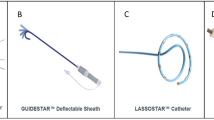Abstract
Introduction. Pulmonary vein (PV) isolation has emerged as a promising technique for the treatment of patients with drug-refractory atrial fibrillation, however, the achievement of transmural lesions has remained a challenge. We evaluated the ability of a novel balloon-based cryogenic catheter system in achieving transmural lesions for PV isolation.
Methods. Six pulmonary vein ostia from three excised ovine hearts and lungs were used in this study. The balloon catheter was deployed and positioned at the ostia of the PVs and a full 8-minute ablation was then performed, while the heart was bathed in a circulating bath of normal saline at 37∘. Thermocouples positioned on the endocardial (balloon surface—tissue interface) and epicardial surfaces of the ostia were used to determine whether transmural freezing was achieved.
Results. The mean temperatures measured on the endocardial and epicardial tissue in six PV ablations were −38.8∘ ± 6.9∘C and −10.0∘ ± 7.5∘C, respectively. The average pulmonary vein thickness was 3.3 ± 1.4 mm.
Conclusions. A novel cryoablation balloon catheter is capable of achieving transmural freezing of the pulmonary vein. The catheter has promise for future clinical therapy of atrial fibrillation.
Similar content being viewed by others
References
Wolf PA, Abbott RD, Kannel WB. Atrial fibrillation: A major contributor to stroke in the elderly. The Framingham Study. Archives of Internal Medicine 1987;147:1561–1564.
Chen SA, Tai CT, Tsai CF, Hsieh MH, Ding YA, Chang MS. Radiofrequency catheter ablation of atrial fibrillation initiated by pulmonary vein ectopic beats. Journal of Cardiovascular Electrophysiology 2000;11:218–227.
Haissaguerre M, Gencel L, Fischer B, Le Metayar P, Poquet F, Marcus FI, Clementy J. Successful catheter ablation of atrial fibrillation. Journal of Cardiovascular Electrophysiology 1994;5:1045–1052.
Haissaguerre M, Jais P, Shah DC, Takahashi A, Hocini M, Quiniou G, Garrigue S, Le Mouroux A, Le Metayar P, Clementy J. Spontaneous initiation of atrial fibrillation by ectopic beats originating in the pulmonary veins. N Engl J Med 1998;339:659–666.
Haissaguerre M, Shah DC, Jais P, Hocini M, Yamane T, Deisenhofer I, Garrigue S, Clementy J. Mapping-guided ablation of pulmonary veins to cure atrial fibrillation. Am J Cardiol 2000;86:K9–K19.
Saad EB, Marrouche NF, Saad CP, Ha E, Bash D, White RD, Rhodes J, Prieto L, Martin DO, Saliba WI, Schweikart RA, Natale A. Pulmonary vein stenosis after catheter ablation of atrial fibrillation: Emergence of a new clinical syndrome. [see comment][summary for patients in Ann Intern Med. 2003 Apr 15;138(8):1; PMID: 12693916]. Annals of Internal Medicine 2003;138:634–638.
Pappone C, Rosanio S, Oreto G, Tocchi M, Gugliotta F, Vicedomini G, Salvati A, Dicandia C, Mazzone P, Santinelli V, Gulletta S, Chierchia S. Circumferential radiofrequency ablation of pulmonary vein ostia: A new anatomic approach for curing atrial fibrillation. [see comment]. Circulation 2000;102:2619–2628.
Oral H, Scharf C, Chugh A, Hall B, Cheung P, Good E, Veerareddy S, Pelosi F Jr, Morady F. Catheter ablation for paroxysmal atrial fibrillation: Segmental pulmonary vein ostial ablation versus left atrial ablation. Circulation 2003;108:2355–2360.
Garratt C, Camm AJ. The role of cryosurgery in the management of cardiac arrhythmias. Clinical Cardiology 1991;14:153–159.
Holman WL, Ikeshita M, Lease JG, Ferguson TB, Lofland GK, Cox JL. Alteration of antegrade atrioventricular conduction by cryoablation of peri-atrioventricular nodal tissue. Implications for the surgical treatment of atrioventricular nodal reentry tachycardia. Journal of Thoracic & Cardiovascular Surgery 1984;88:67–75.
Holman WL, Ikeshita M, Lease JG, Smith PK, Lofland GK, Cox JL. Cryosurgical modification of retrograde atrioventricular conduction. Implications for the surgical treatment of atrioventricular nodal reentry tachycardia. Journal of Thoracic & Cardiovascular Surgery 1986;91:826–834.
Ott DA, Garson A, Jr., Cooley DA, Smith RT, Moak J. Cryoablative techniques in the treatment of cardiac tachyarrhythmias. Annals of Thoracic Surgery 1987;43:138–143.
Author information
Authors and Affiliations
Corresponding author
Rights and permissions
About this article
Cite this article
Garan, A., Al-Ahmad, A., Mihalik, T. et al. Cryoablation of the pulmonary veins using a novel balloon catheter. J Interv Card Electrophysiol 15, 79–81 (2006). https://doi.org/10.1007/s10840-006-8519-5
Received:
Accepted:
Issue Date:
DOI: https://doi.org/10.1007/s10840-006-8519-5




